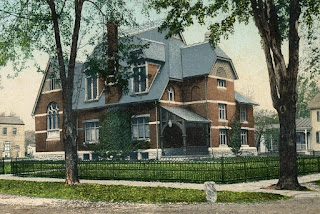Not so many stockings as in the later years, with 20 or more!
Pat remembers that this happened near Christmas. We had lit
candles in each window that shone a glow over the walls. Remember doing strange
animal shadows with hands? Well, Pat added to the complexity by using her toes
and feet. The Famed Bald Eagle was born, and so the legend began…..Many in the 2846
household that Christmas came down with sickness, but not those who were lucky
enough to see the Bald Eagle. Grandma shared the room, so saw the fabled bird
show, and was healthy the entire visit.
Tom and Grandma Taylor, December 1967
When my father, Lloyd
Taylor, died in June, 1969, Mom made a few visits to stay with her kids, but
really wanted to stay in her house, tending her flowerbeds, her garden vegetables
and visiting her neighbors! They had a good circle of friends who visited
often, so we all agreed and made frequent visits ourselves to help her shop and
take her to doctor visits. However, as fall turned to colder weather and snow
was forecast we laid out a schedule that she stay three weeks with Ruth in
Geneva, then three weeks with Esther in Spencerport, three weeks with Doris in
Lockport and three weeks with me in Rochester. Harold and Arnon kept track of
the house in Waterloo in her absence.
Pat's Room in 1971, with bunk beds on the left
We all looked
forward to her coming to our house and each of the kids offered her their bed!
However, it was determined that she’d sleep in what was then Pat’s room and all
that contained was a bunk bed set.
Jim and Chris on Christmas morning, 1969
That didn’t faze
Grandma at all. She decided that she was surely able to climb that little
ladder and make the top bunk. (She was 82.) However, Pat had an idea— she declared
that each night she and Grandma would flip a coin and see who’d sleep up there.
Grandma agreed that was fair. However, Grandma did not know that Pat had
learned from her father how to toss a coin so that it always went the way she
wanted. Thus, night after night, they flipped a coin and it always landed so
that Pat climbed the ladder to the top bunk. Mom wondered, thought she “smelled
a rat” but could see no way “angel face” Pat was cheating.
Thus ended a lovely
visit with Grandma, still unaware of the deviltry she’d witnessed!!
Now, if only Pat could remember that coin trick! It would
come in handy for nephews and nieces at just the right age.
1969 Christmas Tree at 2846
Merry Christmas and Happy New Year's to All on our Cousins Blog!





















